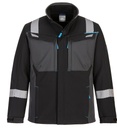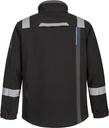FR704 WX3 FR софтшел, Inherent FR
WX3 софтшел јакната е направена од 3 слојна софтшел ткаенина со висока заштита. Користејќи модакрилни и елементи од јаглеродни влакна, овој софтшел обезбедува огнена, хемиска и антистатичка заштита, како и отпорност на ветер, водоотпорност и дишливост. Иновативните карактеристики на дизајнот вклучуваат компоненти без метал, задна вентилација, прилагодливи манжетни, извезени FR логоа и повеќе џебови за доволно чување.,
Карактеристики
Инхерентно пламен отпорни квалитети нема да се намали
Штити од светли и конвективни топлина
Повеќе џебови
100% без метал
Сегментна рефлектирачка лента нанесена со топлина за зголемена видливост
Високо видливи бои
Затегнувач за манжетни со лепенка за сигурност
Испуштена задна капуључа за подобра заштита
Пропустливи од позади за дишливост и удобност
Нов модел
CE-CAT III
Овој симбол означува дека ткаенинате има UPF рејтинг 40+ и блокира 98% од UV зраците кои паѓаат врз облеката
Сертифицирано од европската комисија
Направена од трајна дишлива, отпорна на ветер и вода ткаенина
Отпорно на ветер
8 џебови за обемно складирање
Материјали:
Ткаенина на внатрешноста: Modaflame софтшел 100% полиестер 95g ламиниран на TPU огноотпорна мембрана 35g и врзан со 60% Modacrylic, 39% памук и 1% јаглеродни влакна инхерентен огноотпорен флис 220гр, вкупна тежина, 350g
Стандарди
EN ISO 11612 (A1 B1 C2)
EN ISO 11611 Класа 2 (A1)
EN 1149-5
IEC 61482-2 IEC 61482-1-2 APC 2
IEC 61482-2 IEC 61482-1-1 (ELIM 11 CAL/CM²)
EN 13034 ТИП PB [6]
| Големини - Облека | S - Small or M - Medium or L - Large or XL - XLarge or XXL - XXLarge or XXXL - 3XLARGE |
| Боја | BKR Црна |

?unique=17ba355)
?unique=17ba355)


